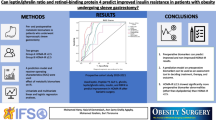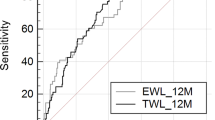Abstract
Background
Leptin and ghrelin appear to play a role in weight regain after a successful weight loss. The pre-treatment plasma levels of leptin/ghrelin ratio (L/G) could have power to predict this clinically relevant issue in the obesity treatment.
Objective
To evaluate the ability of the L/G as a non-invasive tool for the early discrimination of obese patients who are more likely to regain weight after an energy restriction program (regainers) from those who maintain the lost weight (non-regainers).
Subjects and methods
Fasting leptin and ghrelin levels were evaluated in 88 overweight/obese patients who followed an 8-week hypocaloric diet program and were categorized as regainers (≥10 % weight-lost regain) and non-regainers (<10 % weight-lost regain) 6 months (32 weeks) after finishing the dietary treatment. A receiver operating characteristic (ROC) curve analysis was employed to evaluate the diagnostic value of the L/G ratio and to establish a cut-off point to differentiate regainers from non-regainers.
Results
Regainers showed a statistically higher baseline (week 0) and after treatment (week 8) L/G ratio than non-regainers. The baseline L/G ratio was associated with an increased risk for weight regain (odds ratio 1.051; p = 0.008). Using the area under the ROC curve (AUC), the L/G ratio significantly identified female (AUC = 0.69; p = 0.040) and male regainers (AUC = 0.68; p = 0.030). The maximum combination of sensitivity and specificity was shown at the cut-off point of 26.0 for women and 9.5 for men.
Conclusions
The pre-intervention fasting leptin/ghrelin ratio could be a useful non-invasive approach to personalize obesity therapy and avoid unsuccessful treatment outcomes.




Similar content being viewed by others
References
Maclean PS, Bergouignan A, Cornier MA, Jackman MR (2011) Biology’s response to dieting: the impetus for weight regain. Am J Physiol Regul Integr Comp Physiol 301:R581–R600
ter Bogt NC, Bemelmans WJ, Beltman FW, Broer J, Smit AJ, van der Meer K (2011) Preventing weight gain by lifestyle intervention in a general practice setting: three-year results of a randomized controlled trial. Arch Intern Med 171:306–313
Flegal KM, Carroll MD, Kit BK, Ogden CL (2012) Prevalence of obesity and trends in the distribution of body mass index among US adults, 1999–2010. JAMA 307:491–497
Gutierrez-Fisac JL, Guallar-Castillon P, Leon-Munoz LM, Graciani A, Banegas JR, Rodriguez-Artalejo F (2012) Prevalence of general and abdominal obesity in the adult population of Spain, 2008–2010: the ENRICA study. Obes Rev 13:388–392
Abete I, Parra MD, Zulet MA, Martinez JA (2006) Different dietary strategies for weight loss in obesity: role of energy and macronutrient content. Nutr Res Rev 19:5–17
Fernandez JM, Rosado-Alvarez D, Da Silva-Grigoletto ME et al (2012) Moderate-to-high intensity training and hypocaloric Mediterranean diet enhance endothelial progenitor cells and fitness in subjects with metabolic syndrome. Clin Sci (Lond) 123:361–373
Astrup A, Rossner S, Van Gaal L et al (2009) Effects of liraglutide in the treatment of obesity: a randomised, double-blind, placebo-controlled study. Lancet 374:1606–1616
Sumithran P, Prendergast LA, Delbridge E et al (2011) Long-term persistence of hormonal adaptations to weight loss. N Engl J Med 365:1597–1604
Schur EA, Cummings DE, Callahan HS, Foster-Schubert KE (2008) Association of cognitive restraint with ghrelin, leptin, and insulin levels in subjects who are not weight-reduced. Physiol Behav 93:706–712
Levin BE (2004) The drive to regain is mainly in the brain. Am J Physiol Regul Integr Comp Physiol 287:R1297–R1300
Seoane LM, Al-Massadi O, Caminos JE, Tovar SA, Dieguez C, Casanueva FF (2007) Sensory stimuli directly acting at the central nervous system regulate gastric ghrelin secretion. An ex vivo organ culture study. Endocrinology 148:3998–4006
Cummings DE (2006) Ghrelin and the short- and long-term regulation of appetite and body weight. Physiol Behav 89:71–84
Enomoto M, Nagaya N, Uematsu M et al (2003) Cardiovascular and hormonal effects of subcutaneous administration of ghrelin, a novel growth hormone-releasing peptide, in healthy humans. Clin Sci (Lond) 105:431–435
Crujeiras AB, Casanueva FF (2012) Decreased ghrelin levels: the cause of obesity and weight regain? Expert Rev Endocrinol Metab 7:127–129
Davis JF, Choi DL, Benoit SC (2010) Insulin, leptin and reward. Trends Endocrinol Metab 21:68–74
Gil-Campos M, Aguilera CM, Canete R, Gil A (2006) Ghrelin: a hormone regulating food intake and energy homeostasis. Br J Nutr 96:201–226
Goyenechea E, Parra D, Crujeiras AB, Abete I, Martinez JA (2009) A nutrigenomic inflammation-related PBMC-based approach to predict the weight-loss regain in obese subjects. Ann Nutr Metab 54:43–51
Mutch DM, Pers TH, Temanni MR et al (2011) A distinct adipose tissue gene expression response to caloric restriction predicts 6-mo weight maintenance in obese subjects. Am J Clin Nutr 94:1399–1409
Wang P, Holst C, Andersen MR et al (2011) Blood profile of proteins and steroid hormones predicts weight change after weight loss with interactions of dietary protein level and glycemic index. PLoS ONE 6:e16773
Goyenechea E, Crujeiras AB, Abete I, Martinez JA (2009) Expression of two inflammation-related genes (RIPK3 and RNF216) in mononuclear cells is associated with weight-loss regain in obese subjects. J Nutrigenet Nutrigenomics 2:78–84
Crujeiras AB, Goyenechea E, Abete I et al (2010) Weight regain after a diet-induced loss is predicted by higher baseline leptin and lower ghrelin plasma levels. J Clin Endocrinol Metab 95:5037–5044
Strohacker K, McCaffery JM, Maclean PS, Wing RR (2013) Adaptations of leptin, ghrelin or insulin during weight loss as predictors of weight regain: a review of current literature. Int J Obes (Lond). doi:10.1038/ijo.2013.118
Crujeiras AB, Parra D, Goyenechea E, Abete I, Martinez JA (2009) Tachyphylaxis effects on postprandial oxidative stress and mitochondrial-related gene expression in overweight subjects after a period of energy restriction. Eur J Nutr 48:341–347
Mera R, Thompson H, Prasad C (1998) How to calculate sample size for an experiment: a case-based description. Nutr Neurosci 1:87–91
Obuchowski NA, Lieber ML, Wians FH Jr (2004) ROC curves in clinical chemistry: uses, misuses, and possible solutions. Clin Chem 50:1118–1125
Hanley JA, McNeil BJ (1983) A method of comparing the areas under receiver operating characteristic curves derived from the same cases. Radiology 148:839–843
Elmi A, Hedgire SS, Covarrubias D, Abtahi SM, Hahn PF, Harisinghani M (2013) Apparent diffusion coefficient as a non-invasive predictor of treatment response and recurrence in locally advanced rectal cancer. Clin Radiol 68:e524–e531
Bruns DE, Huth EJ, Magid E, Young DS (2000) Toward a checklist for reporting of studies of diagnostic accuracy of medical tests. Clin Chem 46:893–895
Hlatky MA, Greenland P, Arnett DK et al (2009) Criteria for evaluation of novel markers of cardiovascular risk: a scientific statement from the American Heart Association. Circulation 119:2408–2416
Diaz-Lagares A, Alegre E, Arroyo A et al (2011) Evaluation of multiple serum markers in advanced melanoma. Tumour Biol 32:1155–1161
Popovic V, Leal A, Micic D et al (2000) GH-releasing hormone and GH-releasing peptide-6 for diagnostic testing in GH-deficient adults. Lancet 356:1137–1142
Sturgeon CM, Duffy MJ, Hofmann BR et al (2010) National Academy of Clinical Biochemistry Laboratory Medicine Practice Guidelines for use of tumor markers in liver, bladder, cervical, and gastric cancers. Clin Chem 56:e1–e48
MacLean PS, Higgins JA, Jackman MR et al (2006) Peripheral metabolic responses to prolonged weight reduction that promote rapid, efficient regain in obesity-prone rats. Am J Physiol Regul Integr Comp Physiol 290:R1577–R1588
Campion J, Milagro FI, Goyenechea E, Martinez JA (2009) TNF-alpha promoter methylation as a predictive biomarker for weight-loss response. Obesity (Silver Spring) 17:1293–1297
Crujeiras AB, Campion J, Diaz-Lagares A et al (2013) Association of weight regain with specific methylation levels in the NPY and POMC promoters in leukocytes of obese men: a translational study. Regul Pept 186C:1–6
Altman DG, Bland JM (1994) Diagnostic tests. 1: Sensitivity and specificity. BMJ 308:1552
Larsen TM, Dalskov SM, van Baak M et al (2010) Diets with high or low protein content and glycemic index for weight-loss maintenance. N Engl J Med 363:2102–2113
Sandholt CH, Sparso T, Grarup N et al (2010) Combined analyses of 20 common obesity susceptibility variants. Diabetes 59:1667–1673
Sierra-Johnson J, Romero-Corral A, Somers VK et al (2009) IGF-I/IGFBP-3 ratio: a mechanistic insight into the metabolic syndrome. Clin Sci (Lond) 116:507–512
Acknowledgments
The authors are grateful to the volunteers of the study. They also wish to thank their physician Blanca E Martínez de Morentin, their nurse Salomé Pérez, their dietician María Hernandez and their technicians Verónica Ciaurriz and Ana Lorente for excellent clinical and technical assistance, respectively. They received no additional compensation for this contribution. This work was supported by Linea Especial about Nutrition, Obesity and Health (University of Navarra LE/97), CIBERobn and RETICS/PREDIMED, ISCIII Initiatives. AB Crujeiras, is funded by the ISCIII through a postdoctoral research contract “Sara Borrell” (CD09/00365). A Díaz-Lagares was supported by the Angeles Alvariño-2009 postdoctoral fellowship from the Xunta de Galicia and European Social Fund (ESF) and at present is the recipient of a “Sara Borrell” postdoctoral contract (CD12/00738) from the ISCIII at the Spanish Ministry of Economy and Competitiveness.
Conflict of interest
The authors A. B. Crujeiras, A. Díaz-Lagares, I. Abete, E. Goyenechea, M. Amil, J. A. Martínez, and F. F. Casanueva declare that they have no conflict of interest.
Author information
Authors and Affiliations
Corresponding author
Additional information
A. B. Crujeiras and A. Díaz-Lagares have contributed equally to this work.
Rights and permissions
About this article
Cite this article
Crujeiras, A.B., Díaz-Lagares, A., Abete, I. et al. Pre-treatment circulating leptin/ghrelin ratio as a non-invasive marker to identify patients likely to regain the lost weight after an energy restriction treatment. J Endocrinol Invest 37, 119–126 (2014). https://doi.org/10.1007/s40618-013-0004-2
Received:
Accepted:
Published:
Issue Date:
DOI: https://doi.org/10.1007/s40618-013-0004-2




